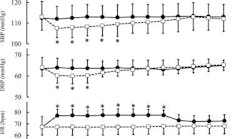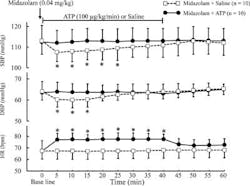The anesthetic drug midazolam is in widespread use for brief dental and medical procedures due to its sedative and amnestic properties. However, cardiorespiratory depression can occur when it is given in higher doses or repeatedly to achieve deeper levels of sedation. A new study tests the ability of an added drug, adenosine 5′-triphosate (ATP), to safely achieve these deeper levels of anesthesia.ADDITIONAL READING |Sedation patients are not your average patients: How they leave the dental practice The current issue of the journal Anesthesia Progress reports results of a study of 10 healthy volunteers who underwent two anesthetic experiments at least two weeks apart. In one session, the volunteers received intravenous bolus administration of midazolam followed by a continuous infusion of ATP for 40 minutes. In the other session, the patients received a placebo infusion of saline after the midazolam.ADDITIONAL READING |Concern over conscious sedation reaches state dental board The patients were monitored for 60 minutes. Changes in systolic blood pressure, heart rate, respiratory rate, and other cardiorespiratory measures were recorded every five minutes. Bispectral index (BIS) was used to evaluate the depth of anesthesia the patients experienced.
BIS analyzes electroencephalogram (EEG) patterns to continuously assess the depth of sedation. The patients’ consciousness was evaluated by their response to verbal commands such as “squeeze my fingers” and “open your eyes.” These parameters showed a deeper level of sedation for the use of midazolam plus ATP. Under midazolam alone, patients showed a BIS value that went from 97 (±1) prior to administration to 68 (±18) after 25 minutes. The volunteers remained conscious, but showed signs of significant cardiopulmonary depressant effects. However, following 15 to 30 minutes of coadministration of ATP, no adverse cardiorespiratory effects were seen and patients became unconscious. The BIS value further reduced to 51 (±13) after receiving ATP. No adverse effects such as hypotension, chest pains, headache, nausea, or vomiting were seen. The authors conclude that the addition of ATP significantly enhances the sedation effect of midazolam with improved cardiorespiratory functions. Full text of “IV ATP Potentiates Midazolam Sedation as Assessed by Bispectral Index,” Anesthesia Progress, Vol. 61, No. 3, 2014, is available here. For more information about Anesthesia Progress, visit their website.







